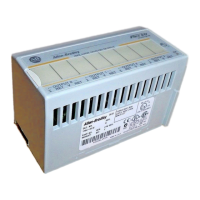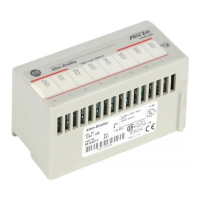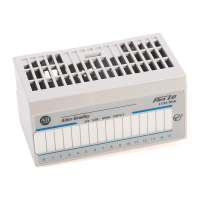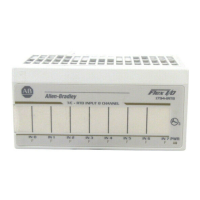Publication 1794-6.5.8 - January 2010
76 Writing Configuration to and Reading Status from Your Module with a Remote I/O Adapter
Chapter Summary
In this chapter, you read how to configure your module’s features and
enter your data.
Word 6 Bit 00–03 Channel calibration selection bit. When this bit is set (1), the channel can be
calibrated using the calibration clock bit (CK). Bit 00 corresponds to input channel 0, bit
01 corresponds to input channel 1, it 02 corresponds to output channel 0, bit 03
corresponds to output channel 1.
Bit 04 Gain/Offset selection bit (GO). – When this bit is cleared, a 0 to 1 to 0 transition of
the CK bit performs on offset calibration. When this bit is 1, the module is directed to do
a gain calibration.
Bit 05 Calibration clock bit (CK). – When this bit is set to 1 (calibration mode), the
calibration coeffiicient for the selected channels is accepted. When this bit is reset (0),
the accepted calibration coefficients for the selected channels are stored, applied, and
the calibration mode exited. Monitor status bits DN and BD for succesful calibration.
Bit 06 Quick Calibration bit (QK). – Normally reset (0). When this bit is set (1) during a
calibration sequence, the calibration coefficient is stored to all related configurations
for the selected channels. NOTE: This method of calibration quickly calibrates the
selected channels, however you will not be within the rated accuracy of the module.
Bit 07 Revert to defaults bit (RV). – Normally reset (0). When set (1) during a calibration
procedure, default values for selected channels are used for the calibration coefficient.
NOTE: You will not be within the rated accuracy of the module.
Bits 08–09
(10–11)
Not used. Set to 0.
Bits 10–11
(12–13)
Request for hold outputs (Q). – Channel request bits that instruct an output to hold its
output level when EN transitions from 1 to 0 to 1. When EN is 0, outputs go to a safe
state dictated by S1/S0. When EN returns to 1, the outputs will hold their level until the
output data equals the output level. P0–P3 indicates channels holding. Output read back
data shows what level is being held. Q0 = bit 08 (10) = channel 0; Q1 = bit 08 (10) =
channel 1, etc.
Bit 12 (14) Interrupt Toggle bit (IT) – This bit, when set (1), permits interleaving of module
interrupts ensuring exchange of critical data when channels are configured for their
fastest update times. RTSI and “no low pass filter” must be 0 in order for the module to
recognize this feature. This groups data update rates for all channels to the slowest
configuration setting of any of the channels. In addition, channel update rates for all
channels with a 7.5ms update rate are reduced to 5.0ms. When reset (0), real time
sampling and filter features are enabled.
Bit 13 (15) Transparent bit (TR). – This bit, when set to 1, permits configuration to be changed
without using the IC bit.
Bit 15 (17) Initiate Configuration bit (IC). – When set (1), instructs the module to enter
configuration mode. Present configuration data prior to or coincident with IC being set.
Once IC returns to 0, the configuration is applied and any subquent configuration
information is ignored until IC is toggled.
Table 4.20
Word/Bit Descriptions for the 1794-IF2XOF2I Analog Combo
Module Write
Write Word Decimal Bit
(Octal Bit)
Definition

